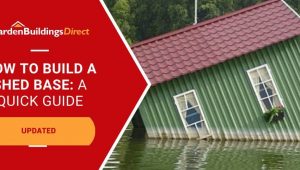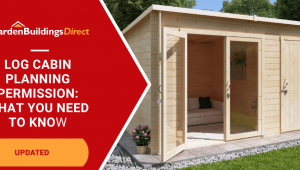Jump to:
Garden log cabins are beautiful buildings that transform the way you experience your garden. But whether you’re using it for family leisure or as a workspace, it is important to look after it. Here are all the essential tasks you need to do to keep your garden cabin in tip-top condition.
Log cabin roof maintenance

Most garden log cabin roofs consist of a frame, tongue and groove boards, and topped with mineral felt or shingles. In the best-case scenario, these materials will last many years without needing any additional work. However, strong wind, rain and hail can take a toll, so it is smart to inspect the roof at least once a month for any signs of leaking.
You can do this inside the cabin by looking up at the ceiling for any gaps where little specs of daylight are visible, as well as for any signs of water having entered the cabin. From the outside, climbing a ladder and taking a close look at the roof felt is a good way to spot any holes that might have formed.
Any large gaps should be patched, and small gaps filled with sealant.
Log cabin timber treatment
It is essential to maintain a log cabin with annual applications of wood treatment. Whether you use coloured paint or a wood stain, a complete coat creates a barrier which prevents the wood from absorbing moisture.

The best time to do this is on a dry day towards the end of summer, so that the timber will have fresh protection ahead of the cold in autumn and winter.
Keeping up the treatment is also essential for the validity of the 10 year guarantee on BillyOh log cabins.
An alternative option to this is to buy a pressure treated log cabin. Choosing pressure treatment (also known as tanalising) at the point of sale means that the parts will be placed into a high-pressure machine after manufacture, which will force preserver deep into the wood fibres. This protection would mean that you would have no need to keep up annual treatments for several years, and it increases the BillyOh guarantee to 15 years.
Discover more about this: What Is Pressure Treatment and How Does It Protect Wood?
For guidance on choosing a treatment and step-by-step instructions on painting, read: How to Paint Your Log Cabin.
Log cabin floor maintenance
Depending on how you use your log cabin, the floor may take a lot of impact. This can be especially true if you’re working out in a garden gym cabin or moving tools around in a log cabin workshop.
Floors in log cabins are usually made of tongue and groove floorboards, starting from 11mm thickness. The thinner the boards, the more easily they can be damaged. You can prevent damage to your log cabin floor by putting down padded mats such as gym floor tiles. Thicker floorboards can make a difference, as long as the bearers underneath don’t have overly wide gaps.
Check the floor integrity of your log cabin at least twice a year for any cracks or holes. If there are any, you will need to replace the damaged floorboards.
How to deal with gaps between boards on a log cabin
The log boards that make up the walls of your log cabin will sometimes form gaps, especially in the first year. The main cause of this is usually subtle expansions and contractions of the wood in response to heat and humidity, especially as boards will not always dry evenly.
If you have a gap where the logs have started to separate, the best response is to loosen the screws in the cabin’s corner framing, so that the upper board can be allowed to drop onto the board below, therefore closing the gap. Repeat this process working up to the top of the building so that the cabin finds its new ideal position. If there are any small gaps left at the end of this process, fill them with a temporary sealant.
It is best not to add fixtures to the walls that will bind multiple logs together until the building has completely settled.
Condensation on log cabin windows
On single-glazed windows, dealing with condensation is as simple as wiping the windows with a towel. It is a good idea to leave the doors and windows open for a while so that the cabin can be fully ventilated and any moisture able to escape. If you can plug in a dehumidifier, this will also help reduce any further condensation on the windows and the building itself.
If you have double-glazed windows in your log cabin, one unfortunate instance that can occur is moisture becoming trapped between the glazing if the seals fail. If this happens, you will need to replace the double glazing. Fortunately, this is not too difficult to do, as the windows are some of the last parts fitted to the building during installation, so you don’t have to take the cabin to pieces to change the windows. With standard wooden-framed windows, replacement units are available from around £100 – just contact us if you need a set.
If you opted for uPVC double glazed windows for the extra security and improved aesthetics, this is even simpler – just pop the beading off the frames, remove the glass, and purchase a replacement set in the same size from whichever supplier you prefer.
Condensation can be prevented through good ventilation and managing the humidity inside your log cabin. Read more about this in our guide: How to Prevent Damp and Moisture in Your Log Cabin.
Get Help from the Log Cabin Experts
Hopefully you now have a solid understanding of the basics for taking care of your garden log cabin.
If you have an issue with your log cabin, whether you need replacement parts or just advice, our customer care team can help you. Just contact us or call 01909 768840.
Shop Log Cabins




